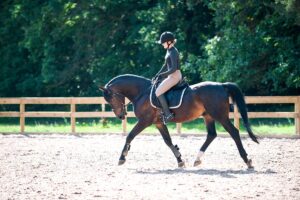First Successful Balloon Valvuloplasty Performed in a Foal

The Dales pony filly was born with a congenital cardiac defect that caused the leaflets of the valve in her pulmonary artery to stick together, blocking blood flow to the lungs. Veterinarians successfully opened the valve by inflating a balloon inserted across her pulmonary valve, through the jugular vein, in a procedure already common in dogs and humans, said Katharyn Mitchell, DVM, PhD, previously at the Clinic for Equine Internal Medicine in the Equine Department at the Vetsuisse Faculty of the University of Zurich, in Switzerland.
“This was an exciting thing for us as large animal cardiologists, to give this little girl a chance at a good quality of life,” Mitchell said.
The day after foaling, the filly presented as weak and feverish, and her treating veterinarian suspected she had failed to acquire colostral immunity from her dam, she said. At the referral clinic, however, tests revealed the foal had successfully received her mare’s antibodies.
However, she had a strong heart murmur, Mitchell said. Ultrasounds and a contrast computed tomography (CT) confirmed the foal had pulmonary stenosis—a blockage in the pulmonary artery due to a congenital valve defect.
“I think she was born with pulmonary stenosis and, in addition, she got an infection, and they were two separate problems,” Mitchell said.
Because echocardiography and contrast CT showed the filly had no other malformations, and because she was the right size physically to be a candidate for balloon valvuloplasty, the scientists opted to attempt the procedure.
“(Her size) was at the limit of how big the balloons are to do the balloon valvuloplasty,” Mitchell explained.
Valvuloplasty arises from research in human patients—and humans are smaller than horses. “They don’t make this equipment specifically for large animals usually (yet), so the technology always comes from the human and small animal side,” she said.
“Human vessels are a certain size, so the balloons are a certain size and, therefore, we have to fit with what’s available for the moment,” said Mitchell. “If she had been any bigger, we wouldn’t have been able to offer valvuloplasty as a procedure.”
That the filly’s condition was limited to pulmonary stenosis alone was another critical factor, Mitchell added. “There are actually very few reports of this defect just by itself,” she said. “Usually, it’s seen in conjunction with other defects, which would have made it a much worse prognosis. The reason we were able to treat this is because it was a single defect.”
Once the filly had completed intensive antibiotic therapy, recovered from sepsis, and was stable, the clinicians performed the balloon valvuloplasty, inserting equipment through the jugular vein under general anesthesia.
Veterinarians viewed the surgery, initially and ultimately, as a success, said Mitchell. While the filly maintained a heart murmur and continued to be slightly lethargic throughout her first year of life, she showed normal behavior and endurance for her age and breed by two years of age, she said.
Mitchell attributes the success to a four-part scientific recipe. “We used a dedicated group of small animal cardiology, advanced imaging, large animal internal medicine, and anesthesia veterinarians, and these were the four key components,” she said. “We worked together as a team very well, and we were able to get a really good outcome. And that’s what’s so satisfying about this case, you know; all the ducks lined up in a row.”
The researchers took advantage of a rare opportunity to apply human and small animal medicine to equine medicine. “We were in a position in which we had a foal for whom we could translate a procedure known in small animals across to horses, and we were able to do something that took her from the brink of not being able to survive to living quite happily,” Mitchell said.
Despite this scientific success, the researchers recommended not accentuating the risk of such congenital defects. “We have no evidence that this congenital malformation is hereditary, but it could be,” she said. “So, our recommendation to the owners was not to breed this horse.”
In general, breeders should be aware of health issues early on in their foals, Mitchell said. “I think the most important thing is to get an overall wellness exam on newborn foals, because that foal exam is really important to pick up any problems that might become apparent later on, such as a lack of good colostral immunity or congenital defects,” she said. “While these remain relatively rare, what’s important to remember is that when they do happen, they can be quite important. So early recognition is key.”
The paper on this case, “Balloon valvuloplasty of valvular pulmonary stenosis in a neonatal foal,” was published August 2021 in the Journal of Veterinary Cariology.

Related Articles
Stay on top of the most recent Horse Health news with


















